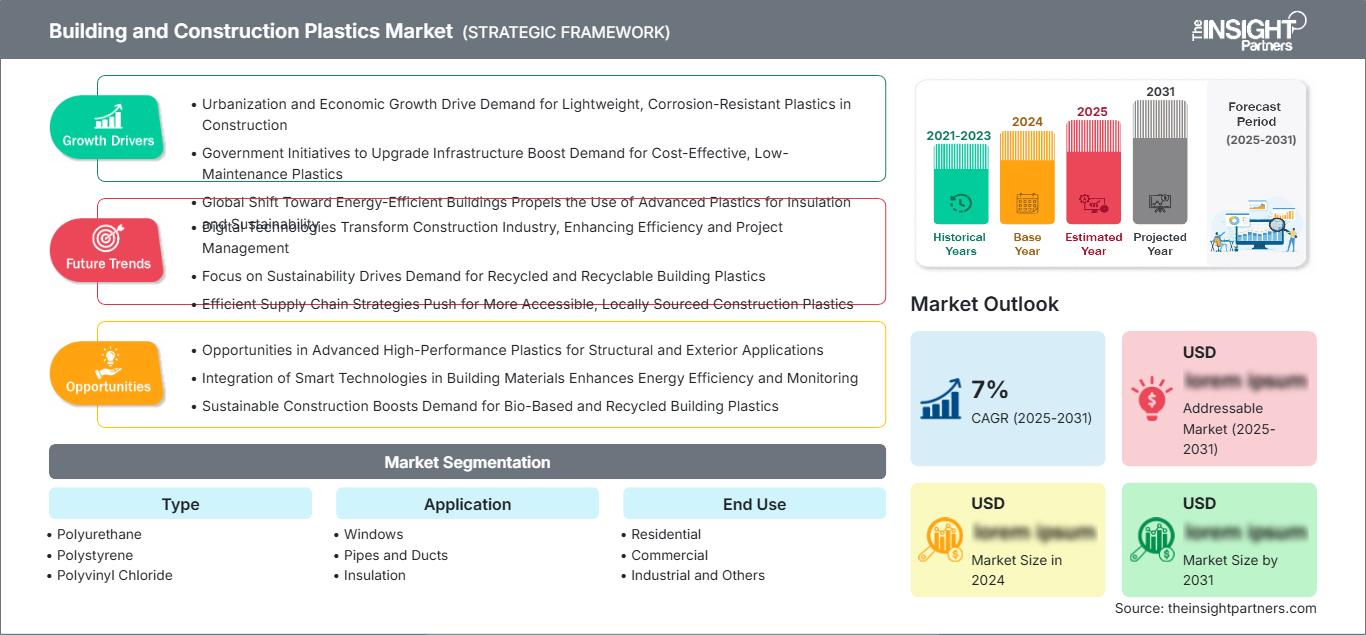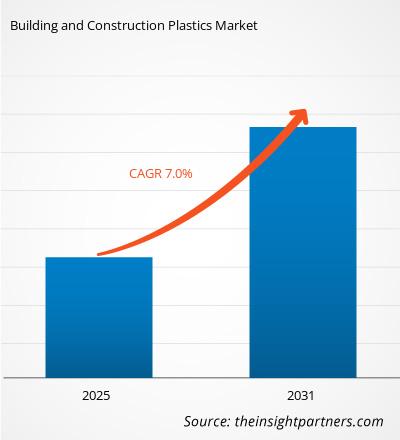The Building and Construction Plastics Market is expected to register a CAGR of 7% from 2025 to 2031, with a market size expanding from US$ XX million in 2024 to US$ XX Million by 2031.
The report is segmented by type (polyurethane, polystyrene, polyvinyl chloride, polyethylene, polycarbonate, polyethylene terephthalate and others). The report further presents analysis based on application (windows, pipes and ducts, insulation, roofing, wall covering and others). Based on end use, the market is segmented into (residential, commercial, industrial and others). The global analysis is further broken-down at regional level and major countries. The market size and forecast at global, regional, and country levels for all the key market segments are covered under the scope. The report offers the value in USD for the above analysis and segments. The report provides key statistics on the market status of the key market players and offers market trends and opportunities.
Purpose of the Report
The report Building and Construction Plastics Market by The Insight Partners aims to describe the present landscape and future growth, top driving factors, challenges, and opportunities. This will provide insights to various business stakeholders, such as:
- Technology Providers/Manufacturers: To understand the evolving market dynamics and know the potential growth opportunities, enabling them to make informed strategic decisions.
- Investors: To conduct a comprehensive trend analysis regarding the market growth rate, market financial projections, and opportunities that exist across the value chain.
- Regulatory bodies: To regulate policies and police activities in the market with the aim of minimizing abuse, preserving investor trust and confidence, and upholding the integrity and stability of the market.
Building and Construction Plastics Market Segmentation
Type
- Polyurethane
- Polystyrene
- Polyvinyl Chloride
- Polyethylene
- Polycarbonate
- Polyethylene Terephthalate and Others
Application
- Windows
- Pipes and Ducts
- Insulation
- Roofing
- Wall Covering and Others
End Use
- Residential
- Commercial
- Industrial and Others
Geography
- North America
- Europe
- Asia-Pacific
- South and Central America
- Middle East and Africa
You will get customization on any report - free of charge - including parts of this report, or country-level analysis, Excel Data pack, as well as avail great offers and discounts for start-ups & universities
Building and Construction Plastics Market: Strategic Insights

-
Get Top Key Market Trends of this report.This FREE sample will include data analysis, ranging from market trends to estimates and forecasts.
Building and Construction Plastics Market Growth Drivers
- Urbanization and Economic Growth Drive Demand for Lightweight, Corrosion-Resistant Plastics in Construction: The increase in the demand for residential and commercial building is a key driver for building and construction plastics. Urbanization and economic growth result in a significant boost to construction activities. Plastics are preferred over other materials mainly due to their lightweight, resistance properties, as well as flexibility of applications for insulation, piping, and cladding.
- Government Initiatives to Upgrade Infrastructure Boost Demand for Cost-Effective, Low-Maintenance Plastics: The strong initiatives being made by various governments to upgrade the infrastructure are quite impacting demand in building and construction plastics. Many nations, in recent times, have been spending a lot on infrastructure activities such as roads, bridges, and public facilities in order to enhance growth and connectivity. Plastics are increasingly used in such applications because they resist corrosion, require less maintenance, and are cost-effective. Thus, the currently ongoing drive to upgrade the infrastructure will also continue to increase demand for plastics materials in construction.
- Global Shift Toward Energy-Efficient Buildings Propels the Use of Advanced Plastics for Insulation and Sustainability: The global shift towards energy-efficient buildings is driving the demand for advanced construction materials. Because of regulations and standards related to saving energy and reducing carbon footprint, construction companies are prompted to use materials that maximize insulation and reduce waste. The use of plastics in modern construction has become prevalent with the rise in thermal insulation and energy-efficient applications.
Building and Construction Plastics Market Future Trends
- Digital Technologies Transform Construction Industry, Enhancing Efficiency and Project Management: The digital technologies aid in improving the eficiency and collaboration in the construction industry. In the recent years, construction planning is executed by tools such as Building Information Modeling, project management software, and mobile applications to transform the way projects are planned and executed. Thus, the developments in construction industry drive the market growth, as a result of better design, visualization, and project management.
- Focus on Sustainability Drives Demand for Recycled and Recyclable Building Plastics: There is also a focus by the construction industry to make construction more sustainable and circular economy-oriented through recycling material content and waste reduction. Consequently, this development leads to the production of recycled content or recyclable building and construction plastics. To this end, companies are also investing in technologies to facilitate recycling plastic waste from the construction process while aligning with global sustainability goals and staying ahead of market competition.
- Efficient Supply Chain Strategies Push for More Accessible, Locally Sourced Construction Plastics: Companies have focused their strategies on making their supply chains as effective as possible through measures such as diversifying suppliers, localizing production, and just-in-time inventory practices. Such developments generate a demand for building and construction plastics that are sourced and delivered efficiently.
Building and Construction Plastics Market Opportunities
- Opportunities in Advanced High-Performance Plastics for Structural and Exterior Applications: High-performance plastics offers lucrative opportunities for manufacturers to formulate new plastic products. Advanced polymer chemistry could lead to the development of materials with improved toughness, strength, and resistance. Such advanced plastics could hence be used in an wide range of applications from structural elements to exterior cladding, which would gain manufacturers a competitive edge in the market.
- Integration of Smart Technologies in Building Materials Enhances Energy Efficiency and Monitoring: Integration of smart technologies into building materials offers an opportunity for the plastics market. The development of plastics that incorporate sensors or even IoT capability might enhance the performance of a building to monitor temperature, humidity, and structural integrity. Since these smart materials can provide building management systems with invaluable data-their implementation can improve energy efficiency.
- Sustainable Construction Boosts Demand for Bio-Based and Recycled Building Plastics: With the growth in sustainable construction, there arises an opportunity to increase the range of products through the integration of sustainable building and construction plastics, with bio-based materials, recycled plastics, or products. Key market players can develop new products, aligning with sustainability goals, thereby tapping rapidly growing market segment and meet the demands of environmentally conscious end users.
Building and Construction Plastics Market Regional Insights
The regional trends and factors influencing the Building and Construction Plastics Market throughout the forecast period have been thoroughly explained by the analysts at The Insight Partners. This section also discusses Building and Construction Plastics Market segments and geography across North America, Europe, Asia Pacific, Middle East and Africa, and South and Central America.
Building and Construction Plastics Market Report Scope
| Report Attribute | Details |
|---|---|
| Market size in 2024 | US$ XX million |
| Market Size by 2031 | US$ XX Million |
| Global CAGR (2025 - 2031) | 7% |
| Historical Data | 2021-2023 |
| Forecast period | 2025-2031 |
| Segments Covered |
By Type
|
| Regions and Countries Covered |
North America
|
| Market leaders and key company profiles |
|
Building and Construction Plastics Market Players Density: Understanding Its Impact on Business Dynamics
The Building and Construction Plastics Market is growing rapidly, driven by increasing end-user demand due to factors such as evolving consumer preferences, technological advancements, and greater awareness of the product's benefits. As demand rises, businesses are expanding their offerings, innovating to meet consumer needs, and capitalizing on emerging trends, which further fuels market growth.

- Get the Building and Construction Plastics Market top key players overview
Key Selling Points
- Comprehensive Coverage: The report comprehensively covers the analysis of products, services, types, and end users of the Building and Construction Plastics Market, providing a holistic landscape.
- Expert Analysis: The report is compiled based on the in-depth understanding of industry experts and analysts.
- Up-to-date Information: The report assures business relevance due to its coverage of recent information and data trends.
- Customization Options: This report can be customized to cater to specific client requirements and suit the business strategies aptly.
The research report on the Building and Construction Plastics Market can, therefore, help spearhead the trail of decoding and understanding the industry scenario and growth prospects. Although there can be a few valid concerns, the overall benefits of this report tend to outweigh the disadvantages.
Frequently Asked Questions
What is the future trend for building and construction plastics market?
Based on geography, which region held the largest share of the building and construction plastics market?
Which is the fastest growing segment based on end use?
What are the key players operating in the building and construction plastics market?
What are the driving factors impacting the building and construction plastics market?
What is the expected CAGR of the Building and Construction Plastics Market?
- Historical Analysis (2 Years), Base Year, Forecast (7 Years) with CAGR
- PEST and SWOT Analysis
- Market Size Value / Volume - Global, Regional, Country
- Industry and Competitive Landscape
- Excel Dataset
Recent Reports
Related Reports
Testimonials
Reason to Buy
- Informed Decision-Making
- Understanding Market Dynamics
- Competitive Analysis
- Identifying Emerging Markets
- Customer Insights
- Market Forecasts
- Risk Mitigation
- Boosting Operational Efficiency
- Strategic Planning
- Investment Justification
- Tracking Industry Innovations
- Aligning with Regulatory Trends





















 Get Free Sample For
Get Free Sample For